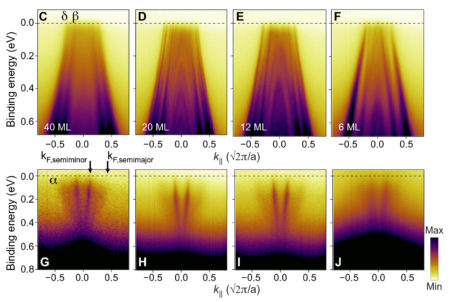SCIENTIFIC ACHIEVEMENT
With the support of data obtained from the Advanced Light Source (ALS), scientists gained new insight into a semimetal’s unusual electronic behavior.
SIGNIFICANCE AND IMPACT
The work lays out a basic strategy for engineering the band structures of semimetallic compounds using dimensional confinement and reveals a new way of creating two-dimensional electron/hole gases by exploiting interfacial bonding.
Rare-earth monopnictides
New materials that pair rare-earth elements (lanthanum through lutetium on the periodic table) with pnictogens (nitrogen, phosphorus, arsenic, antimony, and bismuth) attract immense scientific attention for their interesting properties. Combined with other elements and semiconductors, they are well suited for applications ranging from thermoelectrics to solar cells and semiconductor devices.
One emergent property of rare-earth monopnictides is a remarkably large magnetoresistance (a change in resistance under magnetic fields) that, unlike other forms of this phenomenon, does not saturate at high field strengths. Several mechanisms have been proposed to explain this, but definitive results relating nonsaturating magnetoresistance to electronic structure have proven elusive.
Tuning by dimensional confinement
In this work, researchers from the University of California, Santa Barbara (UCSB) and theory collaborators at the University of Delaware explored the origins of nonsaturating magnetoresistance in lutetium antimonide (LuSb), a rare-earth monopnictide semimetal, grown on a substrate of gallium antimonide (GaSb), a semiconductor with a closely—but not exactly—matching lattice.
Nonsaturating magnetoresistance in LuSb has been attributed to either topologically nontrivial surface states or to a delicate balance between electrons and holes (i.e., charge-carrier compensation). By studying progressively thinner films of LuSb, the researchers shed light on the question by using dimensional confinement as a tuning knob for correlating band-structure modifications with changes in magnetoresistance.
To ALS in a UHV suitcase
The UCSB group, which specializes in synthesizing nanostructures from dissimilar materials, sealed their samples inside an ultrahigh vacuum (UHV) “suitcase” for transport from the lab to the sample chamber at ALS Beamline 10.0.1 without exposure to air. Development of the suitcase, a joint effort between ALS staff and the UCSB group, makes state-of-the-art angle-resolved photoemission spectroscopy (ARPES) feasible to a wider user community by eliminating the need to grow samples in situ, cleave them in the ARPES chamber, or apply laborious sample-preparation procedures.
The ARPES results revealed that, as the samples got thinner, changes at the top of the LuSb valence band reflected a decrease in the number of holes available for conduction. The bottom of the conduction band, however, showed little change, indicating a stable number of electrons. In other words, dimensional confinement clearly affects charge-carrier compensation, resulting in a strong modification in the magnetoresistance of LuSb. Furthermore, there was no evidence of topologically nontrivial surface states.

2D hole gas at the interface

Noting that dimensional confinement alone was insufficient to fully explain the LuSb transport data, the researchers performed further analyses. This revealed another conduction channel—a 2D “gas” of holes—existing at the LuSb/GaSb interface. Ab initio calculations were instrumental in establishing that the 2D hole gas was due to an interfacial band resulting from the bonding mismatch between LuSb and GaSb. The predicted interfacial structure was subsequently verified using transmission electron microscopy. Such interfacial 2D gases, which are expected to be generic at heterointerfaces with a bonding mismatch, can profoundly influence advanced device geometries, including those under investigation for topological quantum computing.
In general, the work lays out a basic strategy for applying confined thin-film geometries and heteroepitaxial interfaces toward band engineering in semimetallic systems. In this case, the strategy allowed control over magnetoresistance behavior while simultaneously providing insights into its origin.
Contact: Chris Palmstrøm
Researchers: S. Chatterjee (Univ. of California, Santa Barbara, and Tata Institute of Fundamental Research, India); S. Khalid and A. Janotti (University of Delaware); H.S. Inbar, A. Goswami, T. Guo, Y.-H. Chang, E. Young, and C.J. Palmstrøm (Univ. of California, Santa Barbara); A.V. Fedorov (ALS); and D. Read (Univ. of California, Santa Barbara, and Cardiff University, UK).
Funding: U.S. Department of Energy (DOE), Office of Naval Research, National Science Foundation, and Leverhulme Trust. Operation of the ALS is supported by DOE, Office of Science, Basic Energy Sciences program.
Publication: S. Chatterjee, S. Khalid, H.S. Inbar, A. Goswami, T. Guo, Y.-H. Chang, E. Young, A.V. Fedorov, D. Read, A. Janotti, and C.J. Palmstrøm, “Controlling magnetoresistance by tuning semimetallicity through dimensional confinement and heteroepitaxy,” Science Advances 7, eabe8971 (2021), doi:10.1126/sciadv.abe8971.
ALS SCIENCE HIGHLIGHT #447